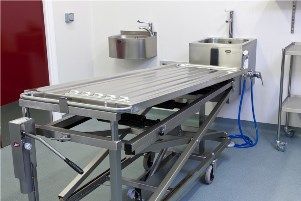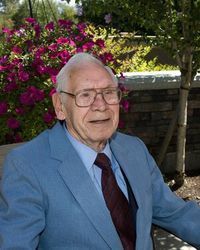Touching Death
She is lying, partially wrapped in a plastic sheet, on a cold metal table in our prep room. Her head is tilted slightly away from me so I can’t see her face yet. I can see she is still in her hospital gown and there is a port still attached to her neck. I take a deep breath and walk toward her. As I come around her head, the row of staples on her scalp goes from her hairline back behind her head where I can’t even see them end. There is another row above her ear and her skull is obviously missing from under her skin between the two tracks. Her curly hair is matted on one side, shaved on the other. I have a full view of her face now.

It is definitely her, but not her. Kathryn, my friend, is lying dead in front of me. We worked together before I became a funeral director. We worked in an intimate environment where co-workers become family. I hadn’t seen her in few years. She traveled for work a lot, I started a different career. But she was my friend. Here she was in front of me, and I had a job to do.
Her wife was meeting me here to prepare her for burial. Lisa had called me when Kathryn died on the East coast, asking me to help bring her home. Kathryn had been through so much in the last few weeks of her life. A sudden medical crisis that was never fully diagnosed culminated in a stroke after many other unexpected complications. Interventions and multiple surgeries had been fruitless. Because she was so young the doctors just kept trying everything to fix her. A week before, Lisa made the incredibly difficult decision to move her to hospice care so that her poor body could finally rest.
Lisa and I had had a long conversation on the phone about embalming. It is not a required procedure in our state or the state that Kathryn died in, but many people just believe it is necessary or even mandatory. Lisa had done her research, and I helped her with the facts and weighing the pros and cons of the procedure, but she made the decision. Kathryn had been through enough, she did not need another invasive procedure on top of all that. She could be shipped home on ice, in a Ziegler Case.
Kathryn was going to be buried in her family’s plot outside town. Since many members of her family had not had a chance to see her before she died, we were going to have the time before the funeral service to let those who wanted to view her have their time to do so. Lisa decided she wanted to prepare Kathryn herself and asked me for my help.
So there I was, standing next to Kathryn’s body, waiting for Lisa. I had arrived early knowing that I would need this time alone with her body. I needed this time for me, so that I could be there for Lisa.

You set up barriers when you work with the dead, both physical and emotional. I have seen literally hundreds of dead bodies in the last few years. When I started in this business, I did removals; picking up bodies from their place of death, and transporting them to our care facility. Physically you are wearing gloves, even gowns when the occasion calls for it. You are not actually coming into contact with the dead person. You don’t know this person. It’s just another body, special to someone else so you treat it with respect, but you have no attachment to it. I would help families dress the body in the home before taking it away if they wanted. Once I helped wash and brush out a woman’s hair while she was still in her bed so that her daughter could make a braid to cut to keep. It’s like manipulating a life size Barbie.
After a few years, I was spending all of my time just in our offices making arrangements with families, rarely seeing the bodies unless there was a service. At that point someone else had prepared the body for viewing, I might help rearrange the hands, or touch up the hair or makeup, but I had very little actual interaction with the deceased.
Barriers have a way of crashing down when it is someone you know, especially an unexpected death of your peer. I knew this wouldn’t just be another body. This was Kathryn. But it wasn’t her. I needed time to sit with her to digest that. I was there to support Lisa. I was the professional. I was the one experienced in death. I took a few minutes just to touch her face and hands, rationalizing the cold I felt with the woman I had known. I finished removing the plastic sheet she had been wrapped in, leaving her hospital gown on. I covered her in a cloth sheet up to her neck. I had offered to have her bathed before Lisa got there, but Lisa was emphatic that she wanted to be involved with everything.
Lisa arrived with three suitcases. She had been having trouble deciding what to dress her in, so she brought everything. I had told her to bring Kathryn’s toiletries. We could use her own shampoo, conditioner (key for us curly haired girls), and soaps. It would help her smell like her again, rather than smelling like hospital.
Outside the door to the prep room, Lisa started to cry. “I’m scared!” she said. I held her for a moment and then started to describe what she’d see when I opened the door. “She’s lying on a metal table, covered in a white sheet but you can see her face. There is a lot of weird looking equipment around because they use this room for embalming but we aren’t using any of that. Her head is really sunken in on the side where she had the craniectomy. Her skin is a bit mottled with patches of red. There are some grey sticky spots on her arms and legs, probably left over adhesive from the medical tape. We can see red veins in her arms and legs where blood has settled. It’s called ‘marbling.’ Her eyes and mouth are closed and are concave looking. It still looks like her, but it’s not her.” Lisa collected herself and I opened the door.
I gave Lisa the same kind of time I needed when I’d first come into the room. She cried, hugged her, touched her, talked to her for a bit.
She looked at me, “What do we do now?”
“Do you want to bathe her?”
“How do we do that?”
With a task at hand, we put on aprons. We removed the remaining tubes and IVs that were on her. I made the conscious choice to forgo the latex gloves for this washing. I wanted to be me, her friend doing this for her, not her funeral director. I turned the water on warm. Lisa laid out the things she had brought. I handed her a washcloth. We started at the shoulders, each of us on each side of her. We passed the soap back and forth as we worked our way down her body. We inched her gown and sheet down as we went, before giving up and removing it all together. Flecks of blood and the medical adhesive washed away. Lisa decided to clip her nails and shave her legs. I washed Kathryn’s hair with her own shampoo and conditioner. I used a comb to get the knots out of the hair that she still had. Once those curls were clean and flowing, she looked much more like herself.
Lisa and I talked some as we worked, told some stories but we were both very much in our own heads working through this. Only after the fact did I think we should have had music playing in the background.
Once Kathryn was clean and dried, Lisa went to choose the clothes. She had been debating whether to put her in a dress, or in street clothes. While Kathryn looked great in a dress, she really was a T-shirt and jeans kinda girl. In the end, Lisa picked out a well-worn pair of Levis, a fitted long-sleeve shirt, and a wool cap with Kathryn’s team’s logo on the front. Lisa and I worked together to get her dressed. We laughed a bit at how difficult it is to dress someone who is not cooperating. I compared it to dressing my tantrum-ing two-year-old, no wait, this was easier. When we were done, tears caught in my throat.
The change was so remarkable. I had come into the room with a body that had been through so much. She looked beat up, cold, lonely, and pained. Once she was dressed, in her own clothes, she looked so cozy, warm, relaxed, and comfortable. She looked like herself. But it wasn’t her.
Lisa laid her head on her wife’s chest and cried. She spoke to her, telling her how much she loved her and missed her. She kissed her. She touched her. She held her.
It was almost as hard to leave the room as it had been to come into it. I helped Lisa pack everything up and walked her out to her car. We hugged for a long time. We’d see each other the next day at the service. I noticed we both took a long time starting our cars and leaving.
It has taken me a few weeks to put this experience into words. The images and emotions are continuing to ricochet around in my head and writing about it helps make some order of the chaos of grief.
I wanted to share this experience so that people can take a look behind the curtain to see that being so closely and intimately involved with someone’s body after they’ve died is an amazing experience. Amazingly painful, amazingly sad, but amazingly rewarding.
Nora Menkin is the Managing Funeral Director at The Co-op Funeral Home of People's Memorial. She has been a funeral director since 2007.






